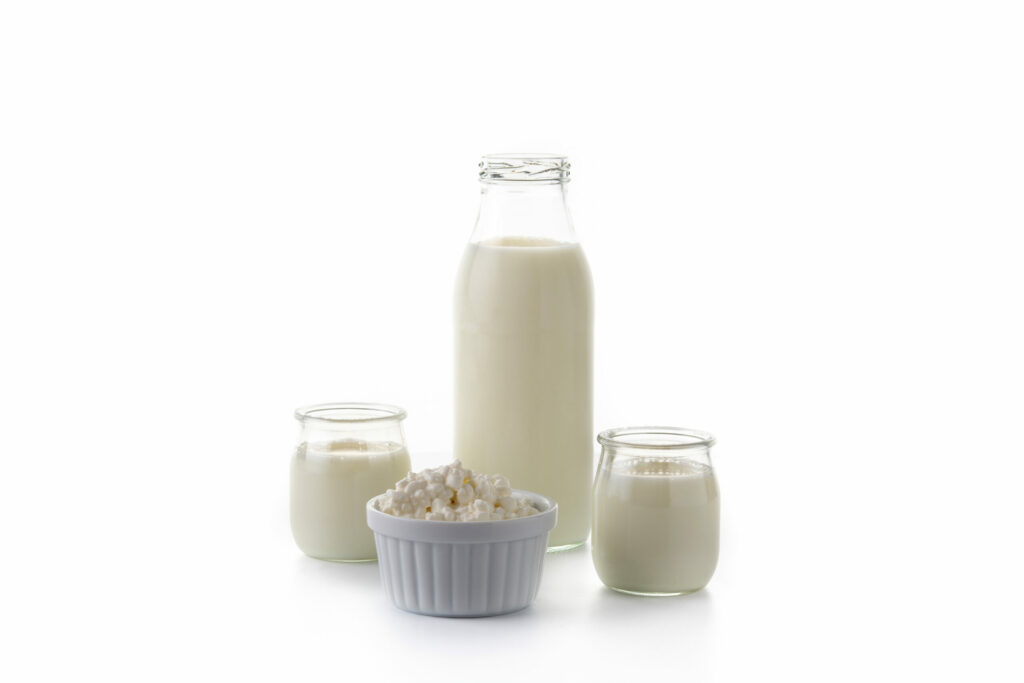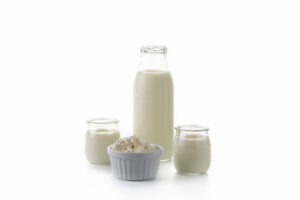
kefir
Kefir is a mildly acidic fermented beverage with high probiotic activity, produced by the addition of lactic acid bacteria and yeasts to milk. The composition of kefir varies according to factors such as milk type and the microbiological composition of culture types; kefir grain or commercial starter culture. The microorganisms in kefir produce vitamins, degrade protein and hydrolyze lactose, resulting in a highly nutritious and digestible functional food.
Why is kefir different than yogurt?
Kefir grains have a complex composition of microbial species with a predominance of lactic acid bacteria while also including acetic bacteria, yeasts, and fungi.
- Kefir has well demonstrated antimicrobial, immunological, anti-tumor and hypocholesterolaemic, anti-hypertensive, and anti diabetic effects, as well as microbiome modulation and b-galactosidase activity. Kefir grains show β-galactosidase enzyme activity, which stays active when consumed. β-galactosidase enzymes found in kefir and yogurt are able to convert gc globulin protein to macrophage activating factors during the fermentation process.
Kefir grain fermentations have been evaluated and a wide variety of bioactive compounds have been observed, such as organic acids, CO2, H2O2, bioactive peptides, exopolysaccharides (kefiran), and bacteriocins. These compounds act independently and together to produce various health benefits. The microbiological and chemical composition of kefir indicates that it is a very complex probiotic, with Lactobacillus species, generally the predominant microorganisms. Kefiran as found in kefir favors the activity of peritoneal macrophages and it also increases peritoneal IgA along with many other benefits including significant anti inflammatory benefits. IgA deficiency is an increasingly common immune deficiency syndrome and is associated with high risk for SIBO and IBD.
- The microorganisms in the kefir grains produce lactic acid, antibiotics and bactericides, which inhibit the development of pathogens. Kefir acts against the pathogenic bacteria salmonella, helicobacter, shigella, staph, e coli, enterobacter, listeria, streptococcus p. , streptococcus f., the fungus Candida albicans and many others.
- Kefir (lactic acid bacteria) inhibits spore formation and aflatoxin produced by Aspergillus, a toxic mold compound.
- The cell-free fraction of kefir or lactic acid bacteria isolated from kefir has been demonstrated to be anti tumoral against gastric, colon, breast, lymphatic and lung cancer.
- Lactic acid bacteria are critical for detox and energy creation as well as having well demonstrated anti inflammatory properties. Probiotic intervention is useful for treatments and conditions that are known to rapidly decrease mucosal glutathione levels like radiation therapy and H. pylori infection.
date nut muffins
Date Nut Muffins are a classic British teatime treat made with sweet dates and toasted walnuts.
Date nut muffins are a handy variation on date nut bread, which originated in Great Britain (specifically Scotland) as a tea time treat. This recipe uses a small amount of brown sugar.
did you know?
Some friendly yeasts as found in kefir are capable of utilizing a variety of sugars and are one of the reasons kefir is so effective at helping to correct metabolic syndrome.
lactic acid bacteria and bifidobacteria in kefir are natural health promoting dairy foods
LAB and bifidobacteria provide an effective way to increase vitamin levels in milk. Folate (vitamin B9) deficiency is linked to neural tube defects, some cancers, poor cognitive performance and heart disease. Instead of synthetic folate, foods can be naturally fortified with folate synthesized by LAB and bifidobacteria. Vitamin B12 deficiency is common, particularly in vegetarians. Animals, plants and fungi cannot produce B12, it is exclusively produced by microorganisms. Biotin (vitamin B7) deficiency can be caused by poor diet or genetic disorders that affect its metabolism. Biotin can be made by some LAB in dairy products.
a healthy microbiome is necessary for mental health
Gamma-aminobutyric acid (GABA) is the main inhibitory neurotransmitter of the central nervous system. Important functions of GABA are neurotransmission, induction of hypotension, diuretic effects, antidiabetic, relaxing and tranquilizer effects.
Most GABA-producing strains are lactobacilli; L. brevis, L. paracasei, L. delbrueckii, L. buchneri, L. plantarum, L. helveticus, Streptococcus thermophilus, and Lactococcus lactis.
Kefir microorganisms produce many vitamins. Yeasts in kefir provide essential growth nutrients such as amino acids, vitamins and favorably alters pH. The essential amino acid contents in kefir are valine, isoleucine, methionine, lysine, threonine, phenylalanine, and tryptophan. Tryptophan, one of the most important amino acids in kefir is of key importance in the nervous system. Kefir contains complete proteins that are partially digested, facilitating digestion by the body. Phosphorus, which is the second most abundant mineral in the human body, aids in the utilization of carbohydrates, fats and proteins for cell growth, maintenance and energy, is abundant in kefir. Fermented milk products lead to a significant increase of butyrate, propionate and total SCFA, in the ascending, transverse and descending colon. Butyrate was the SCFA with the largest increase.
One cup of low fat kefir provides 7-14 grams of protein with about 140 calories. Kefir is beneficial to people who are trying to lose weight. The benefits of consuming kefir are numerous, including nutritional, antibacterial, immunological, anti-tumoural, anti-carcinogenic, anti diabetic, hypocholesterolaemic effects and B-galactosidase activity.
Remember, no more than 6 teaspoons (25 grams) of added sugar per day for women and 9 teaspoons (38 grams) for men. The AHA limits for children vary depending on their age and caloric needs, but range between 3-6 teaspoons (12 – 25 grams) per day. Children under two should have zero grams of sugar per day.
If you like natural health tips like the ones above you can learn more in Immune For Life
